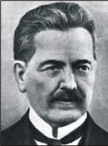Argentine general election, 1916
|
|
||||||||||||||||||||||||||
|---|---|---|---|---|---|---|---|---|---|---|---|---|---|---|---|---|---|---|---|---|---|---|---|---|---|---|
|
||||||||||||||||||||||||||
|
||||||||||||||||||||||||||
|
||||||||||||||||||||||||||
Victorino de la Plaza
National Autonomist Party
Hipólito Yrigoyen
Radical Civic Union
The Argentine general election of 1916 was held on 2 April. Voters elected the President, legislators, and local officials. The first secret-ballot presidential elections in the nation's history, they were mandatory, had a turnout of 62.7% and produced the following official results:
aAbstentions.
Notes: a) seats left vacant.
President Roque Sáenz Peña kept his word to the exiled leader of the Radical Civic Union (UCR), Hipólito Yrigoyen, who in turn abandoned his party twenty-year-old boycott of elections. The president overcame nearly two years of conservative opposition in Congress (and pressure from his own social class) to pass in 1912 what was later known as the Sáenz Peña Law, which mandated universal male suffrage and the secret ballot. His health deteriorating quickly, the President lived to see the fruition of his reforms: the 1914 mid-term elections, which gave the UCR 19 out of the 60 Lower House seats in play (the ruling party obtained 10) and the governorship of Santa Fe Province (then the second-most important). Another beneficiary of the Sáenz Peña Law was the Socialist Party, led by Congressman Juan B. Justo. The formerly dominant PAN remained divided between the Conservative Party, led by the Governor of Buenos Aires Province, Marcelino Ugarte, and the Democratic Progressive Party, led by a reformist publisher and Congressman, Lisandro de la Torre.
...
Wikipedia


